There was already strong bipartisan support in the U.S. Senate for a bill that would direct the National Highway Traffic Safety Administration to require automakers to maintain AM broadcast radio in new vehicles at no additional charge. But with the addition of a dozen lawmakers’ names, the bill now has the required 60 votes to get past any potential hold on the legislation.
It also gives the proposed AM Radio for Every Vehicle Act (S. 1669) the number of votes Senate Majority Leader Chuck Schumer (D-NY) said he needed to bring the bill to the floor for a vote. “Broadcasters are grateful for the overwhelming bipartisan support for the AM Radio for Every Vehicle Act in both chambers of Congress,” NAB President/CEO Curtis LeGeyt said in a statement. “This majority endorsement reaffirms lawmakers’ recognition of the essential service AM radio provides to the American people, particularly in emergency situations.”
News of the 60-vote milestone came as a House subcommittee was holding a hearing Tuesday about the AM bill. But the Senate has been leading the way in the effort. Last July, the Senate Commerce Committee advanced the bill with a near-unanimous vote. Backed by a broad bench of bipartisan support, Sen. Ted Cruz (R-TX) in December attempted to use a parliamentary procedure to force a vote. But it required the unanimous consent of every senator, to which Sen. Rand Paul (R-KY) objected. With 60 co-sponsors onboard, that’s no longer an issue.
In a joint statement, Cruz and bill sponsor Sen. Edward Markey (D-MA) said the AM Radio for Every Vehicle Act said that with a filibuster-proof supermajority in the Senate, Congress should quickly take up the bill and pass it.
“Democrats and Republicans are tuning in to the millions of listeners, thousands of broadcasters, and countless emergency management officials who depend on AM radio in their vehicles,” Cruz and Markey said. “AM radio is a lifeline for people in every corner of the United States to get news, sports, and local updates in times of emergencies. Our common-sense bill makes sure this fundamental, essential tool doesn’t get lost on the dial.”
If passed, the bill would require the Department of Transportation to issue a rule that requires all new motor vehicles to have devices that can access, receive signals, and play content transmitted by AM broadcast stations or digital audio AM broadcast stations installed as standard equipment. If they don’t, carmakers could be fined. And prior to the effective date of the rule, manufacturers that do not include AM would be required to put a warning label on vehicles. The Government Accountability Office would also be required to study and report on whether a reliable alternative communication system exists for delivering emergency alerts.
Critics of the bill have said they are wary of mandating technology that favors one industry. But Markey, who first brought the issue to the attention of Congress and many in radio last December when he wrote to carmakers asking them to detail their plans for AM radio in electric vehicles, has said the bill is not about favoring one industry over another. Instead, he said it is about making sure safety technology is close at hand as emergency alerts become more pressing as climate change impacts the weather.
Little Change So Far Among Carmakers
Some lawmakers have said they hoped the threat of legislation would spur the car industry to return AM radio to vehicles. In January, Inside Radio reported Ford had begun offering a software update to car owners. But no other brand has hit reverse on its decision. Mazda has said it has no plans to reintroduce AM to its first electric vehicle, the MX-30. Tesla and Volkswagen have said the same. Toyota says that while its existing electric vehicles feature AM, the electromagnetic interference caused by the batteries used in EVs has them holding out on committing to future model years.
Other carmakers have said they have no plans to exclude the legacy band from the radio available in their dashboard. That includes Nissan, Hyundai, Kia, Subaru, Land Rover, Jaguar, and Mitsubishi Motors. Honda said that for its two officially announced EVs, both AM and FM will be featured since the models were co-developed with General Motors utilizing GM’s pre-existing Ultium platform.












Comments